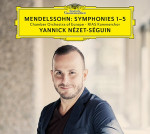|
Back
07/06/2017
Felix Mendelssohn: Symphony n° 1 in C minor, opus 11 (MWV N 13) – Symphony n° 2 (Symphony-Cantata) in B-Flat major “Hymn of Praise”, opus 52 (MWV A 18) – Symphony n° 3 in A minor “Scottish”, opus 56 (MWV N 18) – Symphony n° 4 in A major “Italian”, opus 90 (MWV N 16) – Symphony n° 5 in D minor “Reformation”, opus 107 (MWV N 15)
Karina Gauvin (soprano), Regula Mühlemann (soprano), Daniel Behle (tenor), RIAS Kammerchor, Chamber Orchestra of Europe, Yannick Nézet-Séguin (conductor)
Recording: Philharmonie de Paris, Grande salle Pierre Boulez (February 20-22, 2016) – 200’10
Deutsche Grammophon 00289 479 7337 – Liner notes in English, German and French

   
Yannick Nézet-Séguin divides his time directing the Orchestre Métropolitain, The Philadelphia Orchestra and the Rotterdam Philharmonic Orchestra (for one more season.) He is also now musical director designate at the Metropolitan Opera, succeeding James Levine. Meanwhile, the ubiquitous 43 year-old is also pumping out a lot of recordings for Deutsche Grammophon, his most recent with the Chamber Orchestra of Europe (COE) with recordings of Mendelssohn Symphonies recorded live last year at the Philharmonie de Paris, impressively, over a three day stretch.
This Mendelssohn collection is a vibrant follow-up to their 2015 recording of Le nozze di Figaro, lauded for its chamber orchestra and vocal dynamics. The chamber ensemble synergy is robustly present on these live sessions of Mendelssohn’s symphonic repertory.
In the liner notes, Nézet-Séguin states, “All five symphonies reveal a stupendous command of counterpoint. The way he develops separate voices and weaves them together is ...phenomenal. He strives for maximum clarity.” And this is one of the keys in Nézet-Séguin’s approach to this body of work that distinguishes these live sessions. In concert the Montreal-native gives orchestral counterpoints a distinct drive, and he is particularly skilled at conjuring the sustained musical character of larger symphonic works.
Both the theatrical arc and the inner drives are very much present in Mendelssohn’s Symphony n° 1. Its forceful tempos carry one away with glittering orchestral sharpness, then giving way to the darker temperament in the second movement with its exquisite ascending reed lines and supple lower strings, drawing one into the internal chambers of the symphony beyond a surface of lushness and poignancy.
After this powerful performance is the profound Symphony n° 3 (“Scottish”) with its stirring thematic opening found in the tumultuous first movement, rolling out orchestral rhythms and mystical resolves. Perhaps the highlight of these recordings is an altogether defining performance of Mendelssohn’s noble and stirring third movement, “Adagio”...it’s easy to get lost in the meditative Scottish atmosphere, but Nézet-Séguin’s masterful balance sustains a theatrical arc.
These qualities are also present in the “Italian” Symphony, Mendelssohn’s perennial crowd pleaser. Even in this textbook performance by the COE, it is particularly vibrant with Nézet-Séguin’s tempos bouncing at a tempered gallop, the matrix of orchestral streams laced with Mendelssohn’s balletic lyricism.
In concert, Nézet-Séguin has been lauded for his interpretations of sacred music, requiems and oratorios by Mahler, Mozart, Brahms and Bach, among others, so it’s not a surprise that he would want to record Mendelssohn’s Symphonies n° 2 and n° 5 with themes of God, humanity and faith. In many ways, these are the most musically compelling amongst these recordings.
Purportedly paying homage to Beethoven and Handel, the Symphony n° 2 (“Hymn of Praise”) isn’t derivative at all, but is, in fact, full of innovation. Mendelssohn composes with more understated drama, and with the RIAS Kammerchor (and soloists) the orchestra-vocal dynamic is more modernistic. RIAS Kammerchor’s towering voice makes this a defining performance: they never recede as an emotionally distant sound field. Instead, they’re directed as an equal component to soloists and orchestra. Their full dimension is immediately realized in the opening choral response, “Alles, was Odem hat, lobe den Herrn.” Subsequent responses are sung by sopranos Karina Gauvin and Regula Mühlemann and tenor Daniel Behle, all maintaining dramatic power. The Gauvin/Mühlemann duet (“Ich harrete des Herrn”) is sublime with its tonal effect and Mozartian beauty.
The collection closes with the “Reformation” Symphony with M. Nézet-Séguin returning to Christopher Hogwood’s oft-omitted restorative version which leads into a triumphant ending that’s transporting, even rapturous, to this secular ear.
Equalization and acoustical purity of these live recordings were impeccably engineered by Dimitri Scapolan and Yves Baudry with mastering by StudioeXport’s Lennart Jeschke. Unfortunately, there is no listing of credits for the COE, so it was impossible to cite specific players [of note] for their stellar technical artistry.
Lewis J. Whittington
|